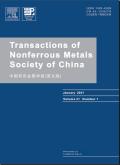热机械处理对 Cu-6.5Fe-0.3Mg 合金再结晶和抗软化性能的影响
IF 4.7
1区 材料科学
Q1 METALLURGY & METALLURGICAL ENGINEERING
Transactions of Nonferrous Metals Society of China
Pub Date : 2024-09-01
DOI:10.1016/S1003-6326(24)66584-2
引用次数: 0
摘要
使用维氏硬度试验、拉伸试验、扫描电子显微镜和透射电子显微镜研究了通过工艺 1(冷轧热处理)和工艺 2(热/冷轧热处理)制备的铜-6.5Fe-0.3Mg(质量分数,%)合金的再结晶和抗软化性能。通过工艺 2 制备的合金在 300 °C 老化后的软化温度、硬度和拉伸强度分别比工艺 1 制备的合金高 110 °C、HV 15 和 114 MPa。工艺 1 和工艺 2 制备的合金的再结晶活化能分别为 72.83 和 98.11 kJ/mol。两种合金的析出物对晶界和位错的钉扎效应基本相同。软化机制主要归因于位错强化的丧失。较高的铁纤维密度抑制了合金中位错的平均自由迁移路径和晶界迁移,这是工艺 2 制备的合金软化温度较高的主要原因。本文章由计算机程序翻译,如有差异,请以英文原文为准。
Influence of thermomechanical treatment on recrystallization and softening resistance of Cu−6.5Fe−0.3Mg alloy
The recrystallization and softening resistance of a Cu−6.5Fe−0.3Mg (mass fraction, %) alloy prepared by Process 1 (cold rolling heat treatment) and Process 2 (hot/cold rolling heat treatment) were studied using Vickers hardness tests, tensile tests, scanning electron microscopy and transmission electron microscopy. The softening temperature, hardness and tensile strength of the alloy prepared by Process 2 were 110 °C, HV 15 and 114 MPa higher, respectively, than those of the alloy prepared by Process 1 after aging at 300 °C. The recrystallization activation energy of the alloys prepared by Process 1 and Process 2 were 72.83 and 98.11 kJ/mol, respectively. The pinning effects of the precipitates of the two alloys on grain boundaries and dislocations were basically the same. The softening mechanism was mainly attributed to the loss of dislocation strengthening. The higher Fe fiber density inhibited the average free migration path of dislocations and grain boundary migration in the alloy, which was the main reason for higher softening temperature of the alloy prepared by Process 2.
求助全文
通过发布文献求助,成功后即可免费获取论文全文。
去求助
来源期刊
CiteScore
7.40
自引率
17.80%
发文量
8456
审稿时长
3.6 months
期刊介绍:
The Transactions of Nonferrous Metals Society of China (Trans. Nonferrous Met. Soc. China), founded in 1991 and sponsored by The Nonferrous Metals Society of China, is published monthly now and mainly contains reports of original research which reflect the new progresses in the field of nonferrous metals science and technology, including mineral processing, extraction metallurgy, metallic materials and heat treatments, metal working, physical metallurgy, powder metallurgy, with the emphasis on fundamental science. It is the unique preeminent publication in English for scientists, engineers, under/post-graduates on the field of nonferrous metals industry. This journal is covered by many famous abstract/index systems and databases such as SCI Expanded, Ei Compendex Plus, INSPEC, CA, METADEX, AJ and JICST.

 求助内容:
求助内容: 应助结果提醒方式:
应助结果提醒方式:


